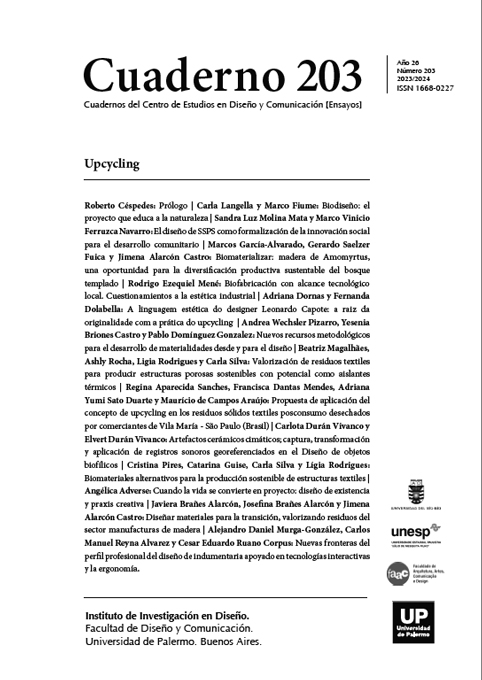Biodiseño: el proyecto que educa a la naturaleza
Resumen
El artículo explora el campo del biodiseño demostrando, a través de una revisión de la literatura científica y la ilustración de los experimentos de investigación de diseño desarrollados por los autores, cómo el diseño puede diseñar artefactos híbridos instruyendo a la naturaleza en la dirección del pensamiento de diseño.
Citas
Adamatzky, A., & Jones, J. (2010). Road planning with slime mould: if Physarum built motorways it would route M6/M74 through Newcastle. International Journal of Bifurcation and Chaos, 20(10), 3065-3084.
Adamatzky, A. (2010). Manipulating substances with Physarum polycephalum. Materials Science and Engineering: C, 30(8), 1211-1220. Adamatzky A. (2019), Slime Mould in Arts and Architecture, River Publishers.
Alexopoulos, C. J., Mims, C. W., & Blackwell, M. (1996). Introductory mycology (No. Ed. 4). John Wiley and Sons.
Ball P., Patterns In Nature. Why the natural world looks the way it does, The University of Chicago Press. 2016.
Barnett, H. (2008). The Physarum Experiments, Studies No: 001-006. Available at: https://youtu.be/oWvAFZsdCg8.Benyus J. M., Biomimicry. New York, Harper Collins, 2002.
Browning, W.D., Ryan, C.O., Clancy, J.O. (2014). 14 Patterns of Biophilic Design. New York: Terrapin Bright Green llc.
Chatterjee A., Vartanian O. (2016). Neuroscience of aesthetics, Annals of the New York Academy of Sciences, vol. 1369, no. 1, pp. 172–194.
Chatterjee A. (2004). Prospects for a cognitive neuroscience of visual aesthetics, Bulletin of Psychology and the Arts, vol. 4, no. 2, pp. 55–60.
Dussutour, A., Latty, T., Beekman M. e Simpson S. (2010). The amoeboid organism solves complex nutritional challenges PNAS, 107 (10), 4607-4611.
Gombrich H. (1984), The sense of order. Study on the psychology of decorative art, Turin, Einaudi.
Frazer J.G. (1922). The Golden Bough. Study on magic and religion, Boringhieri SpA.
Hettinger, N. (2017). Evaluating Positive Aesthetics. Journal of Aesthetic Education, 51(3), 26-41.
Kellert, S., Calabrese, E. (2015). The Practice of Biophilic Design.
Kellert, S. R., & Wilson, E. O. (Eds.). (1995). The biophilia hypothesis. Island press.
Koshenina, G. R. (2020). Etruscan Biophilia Viewed through Magical Amber. University of Mississippi.
Leder, H., & Nadal, M. (2014). Ten years of a model of aesthetic appreciation and aesthetic judgments: The aesthetic episode–Developments and challenges in empirical aesthetics. British journal of psychology, 105(4), 443-464.
Liu, J., Lughofer, E., Zeng, X., & Li, Z. (2018). The power of visual texture in aesthetic perception: An exploration of the predictability of perceived aesthetic emotions. Computational Intelligence and Neuroscience.
Louv, R. (2012). The Nature Principle: Reconnecting with Life in a Virtual Age. Chapel Hill: Algonquin Press.
Martin, G. W. and Alexopoulos, C. J ., Myxomycetes. University of Lowa Press, Iowa City. 1969.
Mealey, L., & Theis, P. (1995). The relationship between mood and preferences among natural landscapes: An evolutionary perspective. Ethology and Sociobiology, 16(3), 247-256.
Myers, W., & Antonelli, P. (2012). Bio Design: Nature. Science, Creativity, MOMA.
Orians, G. H., & Heerwagen, J. H. (1992). Evolved responses to landscapes. Oxman N., Material ecology, New York, 2020.
Rasmussen, T. B. (2006). Bucchero pottery from southern Etruria. Cambridge University Press.
Ryan, C. O., Browning, W. D., Clancy, J. O., Andrews, S. L., & Kallianpurkar, N. B. (2014). Biophilic design patterns: emerging nature-based parameters for health and well-being in the built environment. ArchNet-IJAR: International Journal of Architectural Research, 8(2), 62.
Rolston, H. (1993). Biophilia, selfish genes, shared values (Doctoral dissertation, Colorado State University. Libraries).
Steingraber S. (1985), Etruscan Painting, Catalog Raisonné, Jaca Book.
Stephenson, S. L., Schnittler, M., and Novozhilov, Y., (2008). Diversity and distribution of myxomycetes from the fossil record to the present. Biodiversity and Conservation, 17(2), 285-301.
Los autores/as que publiquen en esta revista ceden los derechos de autor y de publicación a "Cuadernos del Centro de Estudios de Diseño y Comunicación", Aceptando el registro de su trabajo bajo una licencia de atribución de Creative Commons, que permite a terceros utilizar lo publicado siempre que de el crédito pertinente a los autores y a esta revista.


